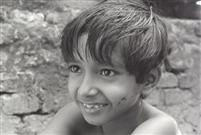|
|
||||
|
|
by Donald Levit  Before Texan Linklater and English Apted, there was Indian Satyajit Ray, who like Japanese Kurosawa put his country (together with composer-sitarist Ravi Shankar and novice cinematographer Subrata Mitra) on the international cinephile map. The story of the Bengali intellectual’s entry into filmmaking and of the genesis, financing and making of his 1955 first, Pather Panchali/Song of the Little Road is the stuff of legend; ditto the Museum of Modern Art and Cannes hosannahs which led to the initially unplanned Aparajito/The Unvanquished the following year and Apur Sansar/The World of Apu three more down the road. As essential, and as innovative, is the history of the complex new 4K restoration of The Apu Trilogy, seldom screened -- and that in prints of inferior quality -- during the more than two decades since the original negatives were burnt in a London fire and considered unusable. The fragile elements of the first two films have been laboriously hand restored by the triumvirate of L’Immagine Ritrovata in Bologna, Academy Film Archive and Criterion Collection, with the irretrievable trilogy-ending reels of the third replaced by restoration from master and duplicate negative. A university-graduate graphic artist in Calcutta (now Kolkata), Ray had designed woodcut illustrations for the autobiographical Bibhutibhusan Banerjee books that would become the starting point. Encouraged by Jean Renoir, location shooting there for The River, and then by films he and his wife binge-watched in England, he found the path in the post-World War Two neorealism of, among others, oft-cited De Sica’s The Bicycle Thief, with dependence on nonprofessional actors, natural or reflected outdoor light, and minuscule budgets for depicting life on the lower echelons of society. Scheduled for release sixty years and five days after the historic MoMA revelation, the bildungsroman three films cover the birth, childhood, adolescence, young manhood, romance and fatherhood of Apu (Subir Banerjee, Pinaki Sengupta, Smaran Ghosal, Soumitra Chatterjee). In the first, freshest and arguably best, he and feisty older sister Durga (Shampa “Runki” Banerjee and Uma Das Gupta) grow up in rural poverty in the natal hamlet to which parents Harihar and Sarbajaya (Kanu Banerjee and Karuna Banerjee) have returned. Along with decrepit but strong-minded “Auntie” Indir Thakrun (retired eighty-year-old stage and silent film actress Chunibala Devi), the siblings deal with their teacher-scribe-writer-religious man Micawber of a father, often away on unsuccessful business, and their unhappy stern mother’s attempts to maintain respectability and make do on near nothing. Twenty-one-year-old Mitra’s camera reflects the joys and sadness of village life and, so strikingly, the subjects’ large liquid eyes and facial planes. Following tragedy heightened by Shankar’s agonized solo tarshehnai raga, framed in their cart the family depart for the holy Ganges city of Benares (now Varanasi), “a fine place except for the monkeys.” Sickness and death again exact their toll in Aparajito, so mother and son leave for the country. In this world of women who mark Apu’s life, she becomes emotionally dependent on him, whereas, grown to beanpole teenager height, he prefers books and studies to accepting or returning maternal attention and, on a small scholarship, goes off to Kolkata to work nights and board at Akhil’s (Kalicharan Roy) New Royal Press and, exhausted, fall asleep days during university classes. Alone and in his early twenties now, the hero is jobless, broke, behind on rent in Apur Sansar but happy playing the flute, writing his novel and rejecting social responsibility. With old college friend Pulu (Swapan Mukherjee), he journeys to the country wedding of the latter’s well-off cousin Aparna (Sharmila Tagore). The previously unseen arranged bridegroom (Tasur Banerjee) proving deranged, virginal Apu assumes the responsibility of righting the bride’s disgrace, and as an unexpected couple the newlyweds move back to his urban indigence. Following a moment of hidden tears, Aparna emerges as sensible, ironic, humorous, capable, loving and soon pregnant. Deeply, ecstatically in love by now, he stays at his new job and the couple part at the station as she returns home for two months and to give birth there. Once more, Apu is alone, and even bright dreams of the future will turn sour and lonely. His yearslong journey to fatherhood and redemptive paternity is rounded out with another of the trains -- in this case, a toy one left behind in grandfather’s (Dhiresh Majumdar, as Sasinarayan) hand -- that have punctuated the trilogy. “The whole point,” the novelist manqué says of his discarded hero, “is facing up to life, not turning his back on humanity.” Indeed before our eyes Apu has grown up. (Released by Janus Films; not rated by MPAA.) |
||
|
© 2026 - ReelTalk Movie Reviews Website designed by Dot Pitch Studios, LLC |



